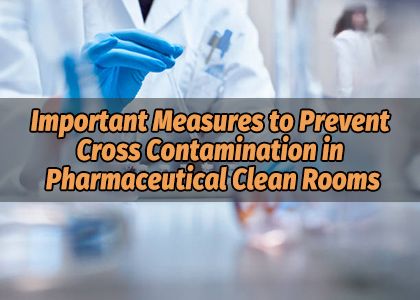
Cross contamination of pharmaceutical process refers to the mixing of different kinds of drug ingredients through the way of personnel, tool transportation, material transfer, air flow, equipment cleaning and disinfection, post clearance, etc., resulting in pollution, or due to the improper flow of people, tools, materials, air, etc., so that the pollutants in the area of low cleanliness into the area of high cleanliness, resulting in cross pollution.
Important measures to control the clean room cross contamination and prevent the occurrence of errors, pollution and cross contamination are one of the core of GMP. So, how to prevent cross-contamination? The Clean Workshop Design Code clearly states that the clean workshop “process layout should be reasonable and compact." Clean rooms or clean areas are only equipped with necessary process equipment and processes and workshops with air cleanliness requirements.”
■ Reasonable layout of space area
Reasonable layout must first straighten out the process flow and avoid roundabout. The flat space of the studio should be reasonable, both conducive to operation and easy maintenance, and spare areas and space should not be reserved. Reasonable space and area are also conducive to reasonable zoning to prevent hybrid accidents.
It should be noted that the clean room is not the bigger the better, the size of the area and space is related to the amount of air supply, determines the size of air conditioning energy consumption, and affects the investment of the project. However, the space area of the clean room can not be too small, too small may not be easy to operate and maintain. Therefore, the design of a reasonable space area should take into account the needs of cleanroom equipment operation and maintenance. The production area and storage area should have a space area commensurate with the production scale to house equipment and materials for easy operation and maintenance. Generally, the height of the clean room is controlled at 2.60 meters, and the individual higher cleanroom equipment can be increased locally, but it is not appropriate to comprehensively improve the height of the clean area. There should be an intermediate station for materials in the workshop, which is large enough to store materials, intermediate products, products to be tested and finished products, and easy to clearly partition to minimize errors and cross-contamination.
■ Improve cleanroom equipment level
The material, processing accuracy, sealing degree and management system of the clean room equipment are all related to cross-contamination. Therefore, in addition to reasonable layout, improving the automation level of equipment and forming a linked production line to reduce operators and reduce the frequency of personnel activity is a necessary measure to prevent cross contamination.
Solid preparation workshop produces large amount of dust. How to prevent cross-contamination in the solid preparation workshop? First of all, the selected equipment should have a protective cover and carry a dust removal device; Secondly, isolation measures should be taken to divide it into the operation room and the front room or the operation room and the auxiliary room. The front room generally adopts single machine and single room in the plane layout, the auxiliary room can be located in the unclean area, and the maintenance door is located on one side of the corridor. Such as tablet pressing, automatic coating, capsule packaging and other equipment can use this separation method. For some single machines without dust removal auxiliary equipment and not sealed, such as shredders, powder or particle packaging machines, the exhaust air in the isolation area can be filtered and returned to the isolation area, that is, the formation of self-circulation.
In the production process, some drugs have strong humidification, and when the relative humidity of the air is required to be less than 50% or even 45%, freezing dehumidification is difficult to meet the requirements. In many dehumidification measures, lithium chloride wheel dehumidification is more suitable. The dehumidifier can be installed in a clean room with special dehumidification requirements, and the purified air is used as the low-humidity protective air of the post, forming its own circulation system.
■ Separate air conditioning purification system
The air conditioning purification system of the clean room should be divided according to different cleanliness levels. For B-lactam, contraceptive drugs, hormones, virulent microorganisms and radiopharmaceuticals, the studio should be set up air conditioning purification system, its exhaust should be installed with efficient filtration equipment, in order to minimize the pollution of these drugs. For clean rooms with different cleanliness levels, clean rooms that produce dust and harmful gases, and positions where the exhaust medium is highly toxic and there are susceptible and explosive gases, a separate local exhaust system should be set up. The exhaust outlet of the clean room should have an anti-backflow device. The opening and closing of supply air, return air and exhaust air should be interlocking devices.
■ Strictly control the flow of people and logistics
The clean room should be equipped with a special flow of people and logistics channels. Personnel should enter according to the prescribed purification procedures, and the number of people should be strictly controlled. The material can be removed after removing the dust and sent through the buffer room or transfer cabinet. Clean area items of different cleanliness levels are transmitted through the pass box. Intermediate stations should be located in a central location in order to shorten the transport distance. There are no pipelines unrelated to this position in the clean area. Make full use of the technical interlayers above and below or around, and all the main pipes of public pipelines and process pipelines are installed in the technical interlayers. The pipe passing through the ground and the partition wall should be as close as possible to the use point and the casing should be laid. The pipe inside the casing should not be welded, and the sealing measures between the pipe and the casing should be understandable. The pipe into the clean room shall be made of stainless steel.